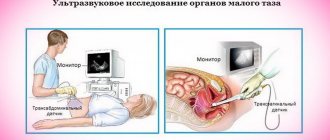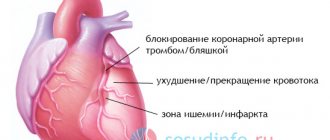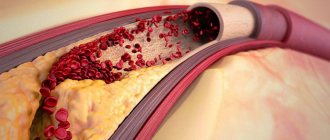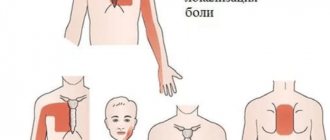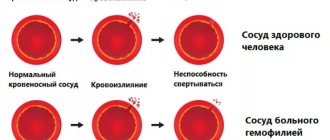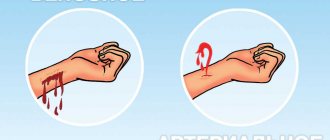Poor circulation in the lower extremities is a consequence of changes in the quality and quantity of blood in the vessels of the legs or as a result of their damage.
In general, circulatory disorders in the legs can be either a concomitant disease, in which specific parts of the vessels are affected, or an independent disease, which is characterized by damage to distal vessels.
The disease has its own classification, which is as follows:
- as a result of impaired patency of the arteries , arterial insufficiency develops, which can have an acute or chronic form;
- when venous outflow is disrupted, venous insufficiency develops, which can also manifest itself in chronic or acute form;
- and finally, polyneuropathy and diabetic microangiopathy .
Reasons for the development of the disorder
There are quite a lot of factors that are responsible for the development of pathology; at present, circulatory disorders in the arteries are usually divided into three main groups:
- peripheral parts are affected , that is, arteries and their further narrowing due to the formation of atherosclerotic plaques;
- artery walls become inflamed;
- arterial spasm is observed .
Such disturbances in the blood flow are often observed due to the following developing diseases:
- Obliterating atherosclerosis , which is caused by the accumulation of fat-like substances and cholesterol in the vessels. Based on this, sclerotic plaques are formed, which over time can lead to either partial or complete blockage of the passage of blood vessels. This disease can affect representatives of any gender and age category.
- The cause of the development of pathology can be an autoimmune vascular disease in a chronic form ( thromboangiitis ). At the same time, due to spasmodic vessels in the thigh area, blood cannot flow to the lower extremities in sufficient volume. Bad habits contribute to the development of this disease. The disease is often observed in young men, males.
- The most terrible complication is diabetic foot , which is the result of vascular damage from diabetes mellitus. If blood does not flow to the legs in the required volume, gangrene may begin to develop. In this case, the affected limbs are amputated.
- Violation of the venous circulation of the lower extremities causes thrombophlebitis and varicose veins . In this case, the blood outflow system is disrupted, and as a result, the walls of the blood vessels weaken.
Types of vascular genesis
The classification of cerebrovascular disorders can be based on the nature of the pathological processes. Possible:
- Acute stage . In this case, the patient most often experiences a stroke. It occurs suddenly, is characterized by a long course and the development of negative consequences (impaired vision, speech, etc.);
- Chronic cerebrovascular accident . Most often it appears as a result of atherosclerosis or persistent arterial hypertension.
Vascular genesis of the acute type of brain is divided into two main groups:
- ischemic stroke , which is characterized by the formation of blood clots in the vessels of the brain, as a result of which a sufficient amount of blood does not flow to it. There is an acute lack of oxygen and the death of some areas of neurons;
- hemorrhagic stroke , which is accompanied by the rupture of a blood vessel and the release of a blood clot.
Chronic cerebrovascular accidents develop gradually and do not always have severe symptoms. There are three main stages, which are accompanied by various symptoms.
Symptoms of poor circulation in the legs
The circulatory system is impaired due to blockage or narrowing of the arteries. Often, a person affected by this disease complains of severe pain when walking, which tends to subside at rest.
This phenomenon is called intermittent claudication. This effect can be caused by a number of diseases, but in any case, such symptoms are a sign of problems in the arteries.
The following factors may be responsible for the occurrence of intermediate lameness:
- bad habits (drinking alcohol and smoking);
- diabetes;
- genetic predisposition;
- stressful state;
- obesity;
- failure of the lipid metabolism system;
- age.
If a circulatory disorder of the lower extremities is observed in the venous vessels, then it is characterized by pain that can be localized in any part of the lower extremity.
Thus, pain felt in the lower leg, knee, thigh, foot, and in rare cases in the lumbar region may indicate the disease.
Often a symptom of the disorder is weakness in the legs or heaviness, chilliness, numbness or cramps. It is extremely rare that the disease is asymptomatic.
Symptoms
The main signs of cerebrovascular accident are severe headache, loss of balance, numbness of various parts of the body, blurred vision, hearing, pain in the eyes, ringing in the ears, and psycho-emotional problems. Cerebral dysfunction may be accompanied by loss of consciousness. With osteochondrosis, pain is noted in the cervical spine.
Symptoms of pathology are usually combined into syndromes characterized by similar organic and functional signs and causes. The leading manifestation of cephalgic syndrome is a sharp, severe headache, accompanied by a feeling of fullness, nausea, intolerance to bright light, and vomiting.
Dissomnia syndrome is associated with sleep disturbances. At night the patient suffers from insomnia, during the day he is attacked by drowsiness.
Vestibulo-atactic syndrome is characterized by motor disturbances due to damage to the central and vertebral arteries. The patient falls when walking, shuffles his feet, and cannot always stop.
Features of cognitive syndrome are deterioration of attention, memory, and thinking. The person is unable to find words, repeat them after the doctor, and does not understand what he has just read or heard.
Diagnostic criteria
In order to diagnose circulatory disorders of the lower extremities and prescribe appropriate treatment, it is important for a specialist to clarify a number of factors: cause, location and depth of localization, type (partial or complete closure of the vessel) and degree.
Currently, there is a classification according to the stages of development of blood flow disorders, which depend on the symptoms:
- First , full compensation occurs. In this case, there is chilliness in the feet, tingling, numbness and fatigue, which occurs only after physical exertion.
- The second is insufficiency that occurs during functional loads. In this case, all the symptoms of the first stage are observed, and intermittent claudication may also develop.
- Third , there is insufficiency at rest. There are painful sensations that do not go away at rest and at night.
- Fourth , ulcerative-necrotic changes occur in the legs. In this case, the development of pathology is accompanied by signs of gangrene and ischemic pain. In order to alleviate the condition, patients are prescribed narcotic painkillers.
In order to make a diagnosis, specialists use a wide variety of methods, including palpation, face-to-face examination, austulcation and percussion. In addition, additional research is being conducted:
- Doppler ultrasound of blood vessels;
- angiography;
- capillaroscopy;
- skin temperature is measured;
- MRI with contrast and magnetic resonance angiography.
Diagnostics
If signs of pathology occur, the patient is prescribed a blood test for the general formula, coagulation, features of lipid metabolism, cholesterol, and sugar levels.
Basic instrumental methods include:
- Doppler ultrasound examination;
- electroencephalography;
- magnetic resonance imaging;
- computed tomography;
- electroencephalography.
A consultation with a cardiologist and an ophthalmologist is required. In case of hypertension, the examination is carried out by a nephrologist.
The neurologist checks tendon reflexes, clarifies the nature of the vestibular apparatus disorder, the presence of signs of tremor, and muscle rigidity. Using a special technique, it monitors speech problems, cognitive and emotional disorders.
Traditional treatment of the disease
In order for a specialist to prescribe a treatment method, it is necessary to identify the source of the disorder. Basically, the traditional method of therapy involves a whole range of activities. In addition, a mandatory treatment measure is to take medications that can increase vascular tone and strengthen capillaries.
Traditional treatment for circulatory disorders of the lower extremities can be physiotherapeutic and surgical. Physiotherapy therapy is only suitable for the initial stage of pathology.
In this case, the patient must take a number of drugs: venotonics, geopathic and phlebotropic drugs, lymphotonics and angioprotectors, as well as drugs that improve blood circulation, anti-inflammatory and anticoagulants.
If the stage of the disease is quite advanced, then physiotherapeutic treatment is not enough; surgical measures will be required: open surgery and angioplasty.
The second method involves a puncture in the groin area and the insertion of a special thin catheter with a balloon at the end into the arteries. Thus, the catheter is brought to the place where the blockage occurred and the balloon is inflated to widen the artery. Thus, blood flow is restored. In order to avoid relapse, a stent will be required.
Stages
The development of CNMK goes through 3 stages. At the initial stage, tissue damage is insignificant, the lesions are small in size. Properly selected treatment will correct the resulting pathology. Violations are found mainly in the emotional sphere and are usually attributed to overwork and excessive nervous tension.
A person quickly gets tired, becomes apathetic, irritable, absent-minded, whiny, impulsive, and forgetful. There is a decrease in performance, difficulties with the perception and processing of new information. Headache occurs periodically. After a good rest, all these signs disappear.
At the second stage, the symptoms worsen and become more vivid. The patient loses interest in work, in what previously fascinated him. A decrease in motivation leads to unproductive, monotonous useless work, the purpose of which cannot be explained by the patient himself. Memory and intelligence decrease. Bouts of inexplicable aggression appear. The patient experiences uncontrolled mouth movements, problems with fine motor skills, and slows down movements.
Headaches become more frequent and intense; they are localized mainly in the forehead and crown area. The examination reveals signs of anatomical damage.
At the third stage, the resulting changes become irreversible. Clear signs of dementia appear. The patient often becomes aggressive and cannot control himself. Doesn't understand where he is, unable to tell the time. Problems with vision and hearing arise. He loses the ability to take care of himself, does not understand the meaning and consequences of simple actions. Incontinence of urination and defecation occurs.
What can you do at home?
You can normalize your circulatory system at home. The main thing is that all activities are carried out in conjunction with traditional treatment.
General strengthening procedures
Therefore, the following procedures should be followed:
- contrast shower for feet;
- more movements, sports should become a main part of life (for sedentary work, it is recommended to walk around the workplace once every 40 minutes);
- you should give up bad habits;
- when choosing shoes, you need to pay attention not to appearance, but to material and comfort (no narrow shoes or heels);
- in a relaxed state, the legs should be in a position in which there will be no pressure on them;
- You should massage your feet at least once a day, simply rubbing each foot for 5 minutes;
- you should adhere to a proper nutrition system and avoid fast foods and fatty foods;
- sleep is also an important factor, it must be complete, at the right time for at least 7 hours.
Folk recipes
Traditional medicine is effective, but it is better to use it together with the treatment prescribed by a specialist. This way, problems and complications can be avoided in the future.
As an independent method of treatment, folk recipes can be used in early stages of pathology and only with the consent of a specialist.
Traditional medicine for circulatory disorders involves performing the following measures:
- Every morning, at least half an hour before going out, you need to lubricate your feet with lemon juice . After the product has been absorbed, you can put on your shoes.
- An effective remedy is baths . In this case, a decoction of calamus root and other herbs that have a vasodilating effect should be added to the water. You can also add nettle, oregano, string, thyme, blackcurrant leaves and chamomile to the decoction.
- If varicose veins are observed , then you can prepare the following remedy: dissolve a teaspoon of crushed red pepper in a glass of hot water. The solution should be shaken well before use. The product must be taken 3 times a day for 20 days.
Rehabilitation
Specially designed gymnastic complexes and massage will help restore strength and restore movement to a patient suffering from cerebrovascular accident. Depending on the patient’s condition, he is prescribed the following techniques:
- Gymnastics "Balance". The main goal of this complex is to restore movements and their coordination. It is prescribed to all patients who have regained consciousness. Before moving on to the exercises, give a light massage. The exercises are aimed at kneading the limbs, neck, head, bending the legs and arms. Relatives help you complete them. The complex turns off eye movements and gaze fixation. The load increases as the patient's condition stabilizes.
- Feldenkrais system. The essence of the technique is concentration on new achievements. The patient performs light, varied exercises and enjoys it.
- Voight system. The technique is aimed at stimulating nerve endings and restoring natural movement patterns.
- Microkinesitherapy. This method is based on a specially created map of the body surface, which allows you to influence organs through muscles and skin.
Massage is always used to rehabilitate the victim. Immediately after an attack, he involves stroking or kneading for several minutes. Gradually the intensity and duration increase.
Poor blood circulation in the brain is a complex pathology that accompanies hypertension, atherosclerosis, and problems with the outflow of venous blood. Its symptoms depend on the underlying disease, but are characterized by similar dynamics and consequences - destruction of blood vessels, brain hypoxia, tissue necrosis. The prognosis depends on the timeliness of treatment, the nature of the manifestation and course of the disease.
Strengthening the blood vessels of the legs
In order to strengthen blood vessels, first of all it is necessary to engage in swimming, jogging, cycling and walking are also beneficial.
In addition, you should adhere to other rules:
- Avoid stagnation of blood in the veins . To do this, you need to move as much as possible and not sit in one place for a long time. It is recommended to raise your legs higher at least once a day and stay in this position for at least 5 minutes.
- Clothes should be comfortable and not restrictive . If this does happen, the outflow of blood will slow down. Therefore, for people with a similar problem, it is not recommended to wear corsets, belts and tights.
- Elastic bandages are often used .
- medicinal baths are used to strengthen blood vessels . You need to add a few ice cubes and a herbal decoction to the water. In addition, you can simply wipe the veins with the decoction.
- It also requires performing exercises that involve flexing and extending the foot at the ankle. It is also necessary to rotate your feet in different directions. For better results, you can move your legs back one by one.
- Among other things, it is necessary to use gels, ointments and creams that contain calendula extract and horse chestnut .
Initial manifestations of insufficient blood supply to the brain
The diagnosis of “Initial manifestations of insufficiency of blood supply to the brain” often presents great difficulties and cannot always be made with certainty.
However, highlighting this point is important, as it draws attention to this earliest form of vascular brain damage, when preventive and therapeutic measures are most effective. The diagnosis of initial manifestations of vascular pathology of the brain is made based mainly on the following subjective complaints of the patient:
The diagnosis of initial manifestations of vascular pathology of the brain is made based mainly on the following subjective complaints of the patient:
- headache;
- dizziness;
- noise in the head;
- memory impairment;
- decreased performance.
The basis for diagnosis is only a combination of two or more of these signs that exist for a long time and are constantly or frequently repeated.
They are characterized by their occurrence under circumstances that require increased blood supply to the brain, for example, during intense mental activity, especially if it occurs under hypoxic conditions (in a stuffy, smoky room) or against the background of great fatigue.
In most cases, the cause is atherosclerosis or hypertension.
But the same symptoms can also be caused by other reasons - chronic infections, malignant neoplasms, etc.
The assumption of the vascular origin of the described disorders is supported by rheoencephalography data, as well as the presence of signs of atherosclerotic vascular lesions in other areas (fundus vessels, coronary sclerosis, intermittent claudication, etc.) or symptoms of hypertension (rises in blood pressure, hypertensive retinopathy, left ventricular hypertrophy of the heart) and etc.).
Consequences of the disease
If the process is started, myocardial infarction may develop.
In addition, the risk of stroke increases, and deaths due to complications from cardiovascular diseases increase. Complications during treatment may depend on the manifestation of intermittent claudication. In this case, it will be necessary to eliminate the symptoms of this pathology.
With diabetes, everything becomes significantly more complicated. If this disease is absent, then the condition can be stable for many years, without changes. In some cases, the development of critical ischemia may occur. Moreover, in 25–45% of cases, death is likely.
Poor circulation of the lower extremities is an easily removable pathology if the causes are clarified. The main thing is not to let things take their course. In order to avoid complications, it is recommended to undergo examination once every six months. By leading a healthy and active lifestyle, the risk of developing the disease is significantly reduced.
Classification
The form of development of the disease allows us to distinguish acute and chronic course. Acute is characterized by transient cerebrovascular accidents and stroke. Its main features are the rapid development and rapid onset of symptoms.
A chronic course is characteristic of various types of discirculatory encephalopathy. Signs of the disease appear gradually and increase over several years. The pathology causes many small foci of necrosis, which negatively affect the functioning of the brain. At the first stages, the symptoms are invisible and are usually attributed to overwork, the consequences of acute respiratory viral infection or other causes.
Based on morphological characteristics, it is customary to distinguish between focal and diffuse disorders. The former are characterized by localization in one or several areas, which can be located in a wide variety of areas of the brain. Their appearance is mainly caused by vascular pathologies - ischemic or hemorrhagic stroke, hemorrhages in the subarachnoid areas. Most often, focal lesions occur during the acute course of the disease.
Diffuse disorders include cysts, isolated small hemorrhages and morphological changes.
Transient cerebrovascular accident
Like any other acute disorder, PNMK (ICD-10 code – G45) manifests itself quickly. It is focal in nature, but in some cases it affects the entire brain. Affects mainly adults. The main feature is the possible reversibility of symptoms. After the attack is over, only small signs remain.
Pathology occurs in approximately a quarter of patients with complaints of acute cerebral circulatory disorders. It is caused by hypertension, atherosclerosis, heart disease, and osteochondrosis of the cervical spine. In some cases, the simultaneous influence of several pathologies is noted. Organically characterized by the following characteristics:
- spasm of arteries and veins and resulting stagnation of blood;
- the formation of obstacles in the form of atherosclerotic plaques in the path of blood flow;
- stenosis of the main vessels due to blood loss or myocardial infarction.
The reversibility of the disorder is associated with the preservation of the possibility of blood supply through additional vessels that replace the affected one.
With pathological changes in the carotid arteries, numbness of the body occurs on the side opposite to the side of the lesion, the nasolabial triangle. In some cases, temporary immobility of the limbs is noted, and speech disturbances occur. Damage to the vertebral artery leads to dizziness, loss of memory, and orientation. The patient cannot swallow and sees dots and sparks in his eyes. With a sharp rise in pressure, he develops severe headaches, the urge to vomit, and stuffy ears.
The general concept of PNMK includes hemorrhagic disorders, transient ischemic damage and some vascular disorders, the symptoms of which may vary.
Hemorrhagic disorders occur due to pressure surges, vascular aneurysms and congenital tumor formations in the vessels. Its symptoms usually occur during the day during physical activity. Severe headache, weakness, nausea, rapid breathing, sometimes accompanied by whistling. The person is lost and cannot understand what is happening to him. In some cases, paralysis occurs, the gaze freezes, and the pupils become different sizes.
Symptoms of a transient ischemic attack appear suddenly. Short-term disturbances in movement, vision, speech occur, paralysis and numbness of the face may develop. The person loses orientation, does not remember his name, how old he is. After a few minutes or hours, the symptoms of a microstroke disappear. According to statistics, 10% of patients develop a stroke within a month after an ischemic attack, and in 20% the disease occurs within a year.
Encephalopathy
Cerebrovascular encephalopathy is a chronic disease that is caused by hypertension, atherosclerosis, venous disorders, and trauma. If previously it was considered a disease of the elderly, now it increasingly affects people under 40 years of age. It is customary to distinguish 3 types of DEP depending on the leading cause:
- Atherosclerotic. The disease occurs due to the appearance of protein and lipid growths on the walls of blood vessels. This leads to a decrease in the lumen of blood vessels and a decrease in circulating blood. Both the main highways that provide blood flow to the brain and regulate its volume, as well as small vessels, are affected.
- Venous. In this case, the main role in the development of the disease is played by the disturbance of the outflow of venous blood. Stagnation forms, poisoning the brain with toxins and causing inflammation.
- Hypertensive. The main reason is high blood pressure and the associated processes of formation of spasms, thickening and rupture of vascular walls. The disease progresses quite quickly. Appears in young people. The acute form of the disease may be accompanied by epileptic attacks and excessive agitation. In a chronic course, there is progressive damage to small vessels.
- Mixed. The disease of this form is characterized by signs of a hypertensive and atherosclerotic form. Blood flow in the main vessels decreases, this phenomenon is accompanied by hypertensive crises.
DEP needs to be treated at any stage. Timely use of medicinal and non-medicinal agents will improve the patient’s life prognosis.

